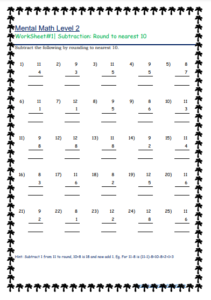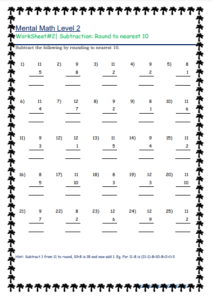Rounding to Nearest Tens Subtraction Strategy
Rounding to Nearest Tens Subtraction Strategy
Rounding to Nearest Tens Subtraction Strategy is a method used to simplify subtraction problems by rounding the numbers to the nearest ten before performing the subtraction. This can make mental or written subtraction easier and can be especially helpful when dealing with large numbers or when you want a quick estimate of the difference.
Here’s how the Rounding to Nearest Tens Subtraction Strategy works:
- Identify the numbers you want to subtract. Let’s say you have two numbers: A and B.
- Round both numbers to the nearest ten. To do this, look at the units digit of each number:
- If the units digit is 0, 1, 2, 3, or 4, round down to the nearest ten.
- If the units digit is 5, 6, 7, 8, or 9, round up to the nearest ten.
- Perform the subtraction of the rounded numbers.
- If you rounded down in step 2, round down in your final answer. If you rounded up in step 2, round up in your final answer.
- If you want an accurate result, adjust for the rounding error by adding or subtracting the difference between the original numbers and the rounded numbers.
Let’s illustrate this strategy with an example:
Example:

Subtract 47 from 92 using the Rounding to Nearest Tens Subtraction Strategy.
- Identify the numbers: A = 92, B = 47.
- Round both numbers to the nearest tens:
- Round 92 to the nearest ten: 90.
- Round 47 to the nearest ten: 50.
- Perform the subtraction of the rounded numbers: 90 – 50 = 40.
- Since we rounded down in step 2 for both numbers, we round down in our final answer.
- To get the accurate result, adjust for the rounding error:
- The difference between 92 and 90 is 2.
- The difference between 47 and 50 is 3.
- The rounding error is 2 – 3 = -1.
So, the final adjusted result is 40 – 1 = 39.
The accurate result of 92 – 47 is 39.
Rounding to the nearest tens subtraction strategy is a useful tool for quick estimations and mental calculations, but it may not always give you the exact result, so be mindful of the rounding error and adjust accordingly if precision is required.
Step 1: Identify the numbers to be subtracted.
Let’s say you have the following problem: 68 – 34.
Step 2: Round each number to the nearest tens place.
- Round 68 to the nearest tens place: 70
- Round 34 to the nearest tens place: 30
Step 3: Perform the subtraction.
Now that you have rounded the numbers, subtract the rounded numbers:
70 – 30 = 40
Step 4: Determine the adjustment.
To get the final answer, you need to determine if you made an adjustment when rounding. In this case, you did, because you rounded 68 up to 70 and 34 down to 30.
- Original subtraction: 68 – 34 = 34
- Adjusted subtraction: 70 – 30 = 40
Step 5: Include the adjustment in your final answer.
Since you rounded 68 up and 34 down, the original subtraction result is adjusted by the difference between the rounded numbers (70 and 30), which is 10.
So, the final answer is 40 + 10 = 50.
Therefore, 68 – 34, rounded to the nearest tens, is equal to 50.
This strategy can help simplify subtraction problems by making them easier to calculate mentally, especially when dealing with numbers that are close to the nearest tens.
How do you explain the Rounding to Nearest Tens Subtraction Strategy.
Rounding to Nearest Tens Subtraction Strategy is a mathematical technique used to estimate the result of a subtraction problem by rounding the numbers involved to the nearest multiple of ten before performing the actual subtraction. This Rounding to Nearest Tens Subtraction Strategy is particularly useful when you want to quickly estimate the answer to a subtraction problem without having to perform precise calculations. Here’s how it works:
- Identify the numbers to be subtracted: In any subtraction problem, you have a minuend (the number you are subtracting from) and a subtrahend (the number you are subtracting). For example, in the problem 47 – 29, 47 is the minuend, and 29 is the subtrahend.
- Round each number to the nearest ten: Look at each number separately and round it to the nearest multiple of ten. To do this, identify the digit in the tens place (the digit immediately to the left of the ones place).
- In the example 47 – 29:
-

Rounding to Nearest Tens Subtraction Strategy - The tens digit in 47 is 4, so you round it to the nearest ten, which is 50.
- The tens digit in 29 is 2, so you round it to the nearest ten, which is 30.
- Perform the subtraction: Now that you have rounded numbers, subtract the rounded subtrahend from the rounded minuend. In our example, you would subtract 30 from 50:
50 – 30 = 20
- Interpret the result: The result you obtained is an approximation of the actual difference. In this case, 20 is an estimate of the difference between 47 and 29 when rounded to the nearest tens.
- Adjust for rounding: To get a more accurate estimate, consider the rounding adjustments you made. In our example, you rounded 47 up to 50 and 29 up to 30, which means you may have overestimated the actual difference. To compensate for this, you can adjust your estimate downward. In this case, subtracting 3 from your estimate of 20 gives you a final estimate of 17.
So, when using the Rounding to Nearest Tens Subtraction Strategy subtraction strategy for the problem 47 – 29, your estimated answer is 17.
Keep in mind that this Rounding to Nearest Tens Subtraction Strategy provides a quick and approximate answer, which can be useful for mental calculations or when you need a rough idea of the result. If precision is required, you should perform the standard subtraction without rounding.


